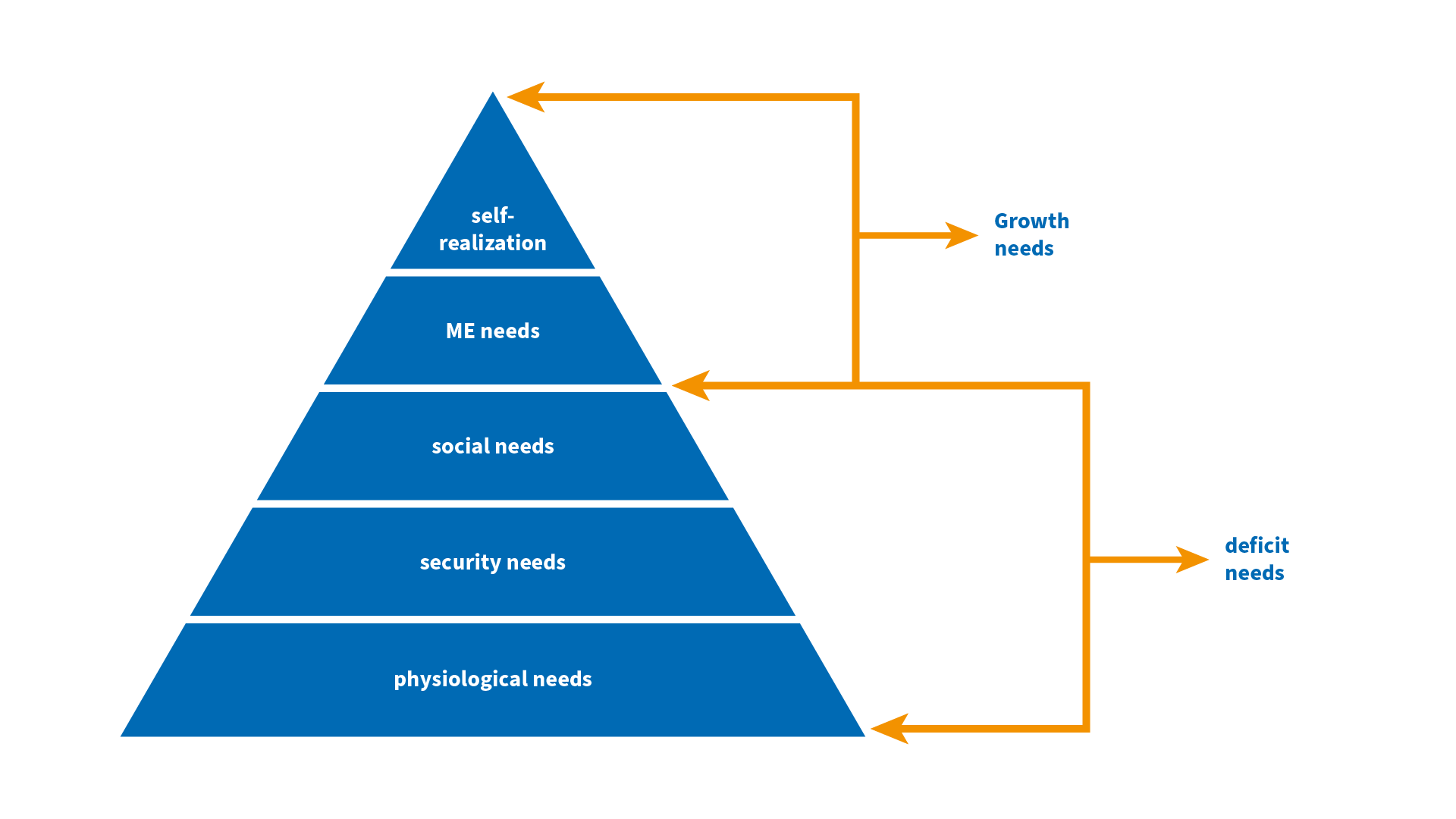
Maslow's pyramid of needs
Discussions on the subject of motivationalways begin with Maslow (from 1954), since he was one of the first to deal with the subject. Therefore, this well-known model is briefly presented.
Motivationmodels attempt to define the fundamentals of the individual's behavioral control based on human needs. Maslow (1908-1970) has probably made the best known contribution to this topic with his pyramid of needs. There are 2 considerations behind this concept:
- He postulates several basic human needs.
- These needs are arranged in a hierarchical tiered structure.
Deficit needs are characterized primarily by the fact that their non-fulfillment causes illness.
Growth needs, unlike deficit needs, cannot be satisfied. They are designed to unfold and are therefore basically limitless.

Maslow's theory still enjoys great popularity today, which is perhaps also supported by the simplicity of the model and its comprehensibility.
The few empirical studies hardly contribute to its support. The relative vagueness of the theory makes it difficult to formulate statements accurately and verifiably. Therefore, there is hardly any scientific interest in this approach today.
The Herzberg two-component theory
A similar fate as Maslow's pyramid of needs also suffers the ever-popular theory of Herzberg (published in 1966). It, too, is no longer up to date, hence in brief:
Herzberg distinguishes between motivational and hygiene factors
Motivational factors: Working conditions that build motivation in the individual as well as cause good work performance. If the factors are not given, this does not necessarily cause dissatisfaction, but the organizational members are not motivated with it either.
Hygiene factors: Working conditions which, if they are not present, cause dissatisfaction in the individual. If these conditions are present, there is no dissatisfaction, but the employees are not necessarily motivated.
Motivating factors are:
- Power
- Recognition
- Work itself
- Responsibility
- Promotion
- Growth
Hygiene factors are:
- Corporate policy/administration
- Monitoring
- Relations with superiors
- Working conditions
- Wage
- Relationships with colleagues
- Own life
- Relations with subordinates
- Status
- Security
Core statements
- There are factors in work systems that make people satisfied and those that make them dissatisfied.
- The most important factors that make people satisfied are: Success in performance, recognition, the work itself, responsibility, advancement and opportunities for development.
- What makes people dissatisfied are: Working conditions, job security, interpersonal relationships, status, colleagues, type and quality of management, pay.
- The absence of dissatisfiers does not make one satisfied; the absence of satisfaction does not make one dissatisfied.
The model is methodologically controversial, lacking sufficient empirical support, but this has notdiminished its popularity.
Both models are based on a weakness: They assume an implicit image of man, which on the one hand is necessary to examine theories, but on the other hand has always remained one-sided in the cases mentioned. Moreover, scientific tests do not support these models. Thus, in order to obtain an approximately realistic picture of human beings, one must assume a multitude of individual needs that guide action.
Reinhard Sprenger's contribution to the topic of motivation
With his book "Mythos Motivation", Reinhard Sprenger provided a much discussed contribution in the German-speaking world, which is not based on empirical studies, but on his personal experiences and observations. Nevertheless, a brief summary of his theoryshould be mentioned, since Reinhard Sprenger has triggered a great deal of discussion, especially among managers.
Sprenger distinguishes motivation from motivating. He understands motivation as the question of the "why" of behavior, while motivating concerns the "how" of behavior. The manager's interest, however, is not why something happens, but how he or she can influence the behavior of employees. So, according to Sprenger, what is commonly referred to as motivation is not motivation, but motivating. Itis the ". Generating, maintaining, and increasing the willingness to behave by the supervisor or by incentives ... For this external control I use the term 'motivation' in clear separation from the individual's own control." Sprenger's subsequent remarks are very striking in showing how little useful common motivational practices are, and how they sometimes turn into their opposite. For example, he cites the 5 big B's of motivation: Threatening, Punishing, Bribing, Rewarding, and Commending, and leads readers* to conclude, "All motivating destroys motivation." One of Sprenger's remarks on the subject of motivating through bonuses found wide appeal among many managers and was given media coverage. Premiums lead to meaninglessness, Sprenger says, because "...often people don't do what makes sense, but what is rewarded."
Sprenger's explanations contain many thoughts that are basically also supported by empirical studies. Motivation and thus also motivation can only arise from within, i.e. from the person himself. Thus, motivation cannot be generated, but each person can only motivate himself. "It is rather a matter of insight into the fact of human freedom of choice." Self-motivation therefore means taking responsibility for motivation and willingness to perform oneself.
Sprenger's remarks are not entirely new. We have known for a long time from neuropsychology that, biologically speaking, activation, emotion and motivation are indistinguishable. Thus, every action arises from the human being itself, and, from that perspective, so does motivation. His contribution is valuable because it has triggered a long-overdue discussion that relegates self-proclaimed motivation gurus and their banal concepts to the corner of unseriousness where they also belong. Sprenger could, however, lead some managers to the fallacious conclusion that they can safely sit back and relax, since they can't contribute anything to motivating their employees anyway. This is a one-dimensional conclusion, albeit an obvious one.
Steven Reiss with the question "Who am I?"
A completely new study on the subject of motivation was presented by Steven Reissin 2000. His book "Who am I" was one of the most cited studies in the Anglo-American world. With his study, Steven Reiss not only presented a completely new contribution to the topic of motivation, but probably revolutionized personality psychology.
So what is fundamentally new?
Steven Reiss does not present a new typology with his study, but a personality theory. The life motives are independent of each other, i.e. the presence of one motive is independent of the presence of all other motives. Thus, there is no hierarchy of motives as we have seen in the models of Maslow and Herzberg. This also means that the motives are not subject to a valuation in the sense that there are higher and lower motives. That is, no motive is superior to another or is considered more desirable.
Reiss's contribution provides more than a theory of motivation. Steven Reiss' findings are more reminiscent of a personality theory, because
- motives determine our behavior per se: to live them is their purpose.
- a person's motive profile is basically stable.
- we find a distinction between "Feel good-happiness" and "Valuebased-happiness". By Feel good-happiness Reiss understands the efforts of a person to create a good feeling as quickly as possible and to find meaning in it, in contrast to Valuebased-happiness, which means to have found the meaning of one's own actions and to align one's life according to one's own values and motives.
- In the clinical-therapeutic field, his theory nourishes Viktor Frankl's Existential Analysis (Man in Search of Meaning).
Last but not least, Reiss' theory is a plea for tolerance: he pleads for the
Understanding and accepting other people's motives. This is because we tend to consider our own values as desirable and to disregard those of others. Thus, in connection with his theory of motives, Steven Reiss presents the 3 aspects of self-centeredness that elevates one's own values above those of others:
3 Aspects of self-centeredness
- Misunderstanding: misunderstandings (it can't be what doesn't fit into my worldview).
- Self-hugging: self-illusion (my values are not only right for me, butfor everyone).
- Everyday tyranny: value tyranny: (the daily attempt to change the other).
Reiss, S. (2000)